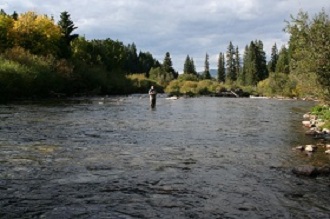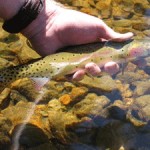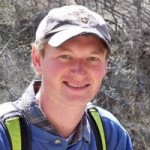Colorado’s backcountry fish and wildlife habitats will enjoy strong protections for the future thanks to a new federal rule that was shaped significantly by anglers and hunters.

The July 2012 release of the final US Forest Service plan for conservation and management of Colorado’s roadless areas was the culmination of a process that spanned the terms of three governors. From the beginning, TU was there, taking part in Governor Owens’ initial roadless task force, periodically meeting with Forest Services officials, and working to secure enhancements right through the final days before the rule was issued.
Why is “roadless” so important to TU? Because roadless areas support prime wildlife habitat that is critical to the survival and recovery of Colorado’s remaining populations of native cutthroat trout. The numbers tell the story about what roadless areas encompass:
- More than 75% of the remaining habitat for Greenback cutthroats
- Nearly 60% of the remaining habitat for Rio Grande cutthroats
- More than 70% of the remaining habitat for Colorado River cutthroats
Native trout and dirt roads are not good partners. Backcountry streams that support native trout are often narrow, not very deep and can experience very low seasonal flows. A single severe thunderstorm can flush so much sediment into a stream that spawning areas are smothered and fish suffocated.
Of course, TU wasn’t alone in its support of a beefed-up backcountry plan. Colorado hunters supported roadless protections because they harbor some of the state’s best big game habitat: More than 50% of elk summer concentration and production areas are in roadless areas, and the 15 most hunted Game Management Units in Colorado all have more than 66,000 acres of roadless lands.
Development of a state-specific Colorado Roadless Rule began during the Bush Administration as an alternative approach to the Clinton administration’s 2001 rule, at a time when the 2001 rule was the subject of multiple lawsuits. Even though the ensuing legal battles ultimately resulted in the affirmation of the Clinton-era rule, Colorado continued to develop its own plan, focusing on local interests and issues. TU participated throughout, always reiterating a simple standard: we would support a Colorado rule only if it was, on balance, as strong as or stronger than the 2001 rule in protecting Colorado’s backcountry.

It was a fruitful strategy. TU’s most notable success was to secure special protection for drainages supporting native cutthroat trout. And while the final rule allows for a range of activities within those drainages, it also requires the Forest Service to ensure that those activities would not result in any long-term declines in cutthroat trout habitat, or in the extent of streams and lakes occupied by the native cutthroat. These protections help ensure that roadless areas continue to serve as an essential and effective refuge for Colorado’s native trout heritage.
The final rule that emerged from the decade-long process contains additional, important protections:
- Establishing an “upper tier” category of roadless lands with protections stronger than those in the 2001 federal rule, including a requirement that oil and gas reserves be accessed through directional drilling, with drill sites sited outside the roadless boundaries. This upper tier includes more than 1.2 million acres of Colorado’s total of 4.2 million roadless acres.
- Closing a loophole in the federal rule that allowed for “linear construction zones” – temporary roads in all but name. Under the new rule, these “LCZs” are greatly restricted.
- Adjusting the federally designated “roadless areas” to reflect more accurate inventories, effectively extending roadless protection to more than 400,000 acres not included under the 2001 rule.
The final Colorado rule does contains some exemptions from the road-building and logging limitations of the 2001 rule, designed to accommodate specific community and economic interests. Most notably, the rule allows for temporary roads and logging to address wildfire risks by conducting fuel treatments in roadless areas adjacent to communities in the so-called “wildland-urban interface.” The Colorado rule also exempts certain areas within the boundaries of existing ski areas, as well as areas overlying some existing coal mining areas within the North Fork of the Gunnison watershed. Another exemption allowing for construction and maintenance of water conveyances with existing water rights was also included.
Colorado TU Executive Director, David Nickum, praised the new rule for its balance between strong protections for key habitats and flexibility when it comes to community protection and economic development. “We recognize the need to deal with issues like fuel reduction around communities,” said Nickum. “But the new rule pairs that flexibility with stronger protections for Colorado’s native trout heritage and its best backcountry lands. It strikes the right balance.”
Trout Unlimited was a central voice in pushing for some of the final changes that helped the Colorado rule meet our standard of being, on balance, as strong as the national rule.
Those changes included strengthened provisions for native trout protection, limitations on the location of water development facilities, and the concept of “upper tier” areas, which were modeled after a state-specific plan created by in Idaho.
There is no question that without the steady and effective involvement of sportsmen throughout the rulemaking process, we would not have achieved the success that we see in the final rule today.
“Colorado’s anglers and hunters understand the connection between healthy fish and game habitat and their ability to fish and hunt successfully on land that belongs to all Americans,” said Chris Wood, President and CEO of Trout Unlimited. “That’s why our volunteer members were engaged in the Colorado rule-making process. This rule, while not perfect, sets the bar pretty high and proves that sportsmen are a force to be reckoned with when it comes to protecting public lands and how they’re managed today, and in the future.”
For more on the importance of backcountry areas, visit Trout Unlimited's report on Colorado roadless areas, Where the Wildlands Are: Colorado
 In June, Rocky Mountain Flycasters (RMF), the Fort Collins area Chapter of TU, began discussing the restoration process in the areas burned by both the High Park and Hewlett Gulch fires.Those two fires burned close to 100,000 acres of forest in the Poudre and Big Thompson watersheds. RMF was gravely concerned what impacts the fires would have on the watersheds.
Using recent Colorado and Western US fires as examples, the chapter knew that restoration costs of those burned areas couldn't be done solely through agency response. The US Forest Service, National Resource Conservation Service, Colorado Parks and Wildlife, Colorado State Forest Service and Larimer County are all first rate organizations, but all these agencies combined lack the resources necessary to address the ecological damage caused this year by our two local fires, Colorado's other wildlifres, and the numerous fires burning throughout the Western US.
In June, Rocky Mountain Flycasters (RMF), the Fort Collins area Chapter of TU, began discussing the restoration process in the areas burned by both the High Park and Hewlett Gulch fires.Those two fires burned close to 100,000 acres of forest in the Poudre and Big Thompson watersheds. RMF was gravely concerned what impacts the fires would have on the watersheds.
Using recent Colorado and Western US fires as examples, the chapter knew that restoration costs of those burned areas couldn't be done solely through agency response. The US Forest Service, National Resource Conservation Service, Colorado Parks and Wildlife, Colorado State Forest Service and Larimer County are all first rate organizations, but all these agencies combined lack the resources necessary to address the ecological damage caused this year by our two local fires, Colorado's other wildlifres, and the numerous fires burning throughout the Western US. Restoration funds collected for the benefit and use by the coalition will be deposited with the Community Foundation of Northern Colorado. Project proposals will reviewed and approved by a HPRC Project Review Committee and funding will only be released to those projects that are approved by the committee.
Restoration funds collected for the benefit and use by the coalition will be deposited with the Community Foundation of Northern Colorado. Project proposals will reviewed and approved by a HPRC Project Review Committee and funding will only be released to those projects that are approved by the committee.

















